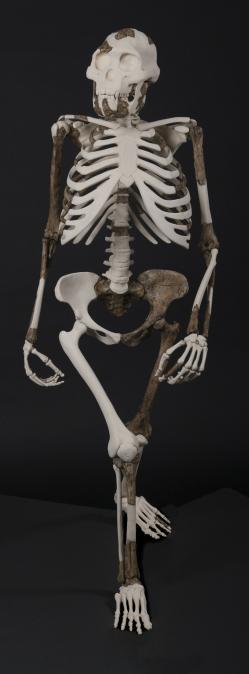Today’s Google Doodle is a lovely animation celebrating the anniversary of the discovery of Lucy, a 3.18-million-year-old Australopithecus afarensis fossil at the Hadar research site in the Afar region of Ethiopia.
On Nov. 24, 1974, paleoanthropologist Donald Johanson and a student, Tom Gray, discovered a forearm bone on a walk back to their car after a long day of fossil hunting, a find that led to a two-week excavation and the discovery of hundreds of bones and fragments that made up 40 percent of a complete skeleton. They named it Lucy.
Since then, our knowledge of human evolution—and our family tree—has expanded greatly. We know of more than 20 different hominid species, including as many as eight in Lucy’s genus, Australopithecus. And yet, Lucy is still arguably the most famous specimen. Why?

Courtesy of the Cleveland Museum of Natural History.
At the time, Lucy was the most complete hominin fossil on record. It can be hard for casual observers to understand how scientists can announce a new species based on a skull, or even on a collection of jawbones, but Lucy could give us a real and easily comprehended glimpse into our past. She was the first to provide evidence that walking on two legs evolved before our larger brains. (And yes, Lucy is a “she.” While the story goes that her name came from the fact that “Lucy in the Sky With Diamonds” blared repeatedly in camp while Johanson and Gray celebrated their discovery, research determined that she was female based on her pelvic bone and sacrum.)
Today, Lucy’s fame makes her an important and valuable icon to help us understand other discoveries. In 2005, a team led by Yohannes Haile-Selassie found a partial afarensis skeleton at the Woronso-Mille research area less than 40 miles from where Lucy was discovered. At 3.6 million years old, “Kadanuumuu” is about 400,000 years older than Lucy, but he was quickly dubbed “Lucy’s great grandfather.”
Other notable afarensis fossils—Lucy’s kin—include the famous Laetoli footprints that a team led by Mary Leakey discovered in 1978 in Tanzania. These footprints indicated that afarensis had feet that were more like humans than apes and that they walked much like we did. And one year after discovering Lucy, Johanson found 200 specimens from at least 13 individuals that became known as the First Family.
Just last May, Haile-Selassie, a curator at the Cleveland Museum of Natural History, named a new species called Australopithecus deyiremeda that is notable because, at 3.3 million to 3.5 million years old, it was living in Ethiopia at the same time as afarensis. Lucy had family, and she also had neighbors.
